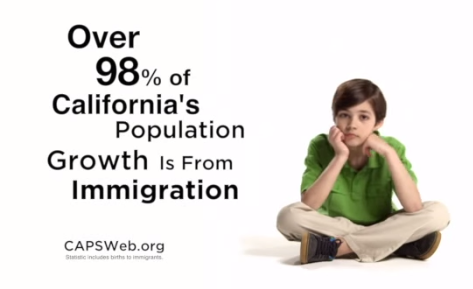Anti-Immigration Group Uses Earth Day To Recycle Argument That Immigrants Destroy Environment

*This Californians for Population Stabilization video is not isolated, it’s part of an effort to use the environment as a wedge against undocumented immigrants and comprehensive immigration reform. A couple of right-edge scientists have a website called Science 2.0 where they launch their attacks against almost all scientific research and fact that they deem to be left-leaning. VL
An immigration-restrictionist group is using Earth Day to blame immigrants for three of California’s most vexing environmental issues: increased car usage, increased population, and water shortage. According to a television ad released by the organization California for Population Stabilization (CAPS) on Wednesday, the ongoing environmental degradation in the state is a result of immigrant-driven population growth.In the ad, a petrified child asks a series of question, while harrowing statistics pop up beside him: “If Californians are having fewer children, why are there so many cars?”; “If Californians are having fewer children, why isn’t there enough water”; and “If Californians are having fewer children, where are all the people coming from?”
The accompanying press statement also released Wednesday claimed that “the link between population growth and environmental degradation has been made in countless scientific studies. More people means more cars, trucks and buses on our roads and more air pollution. More parking lots and high rise condominiums mean less green spaces. More chemicals, trash and runoff cascading down super sewers into our streams, lakes and oceans means more damage to California’s biodiversity hot spots; and more people means more pressure on declining water supplies.”
Jo Wideman, Executive Director of Californians for Population Stabilization added, “Part of the solution to reversing California’s environmental decline, while not politically correct or convenient, is certainly simple. If we slow mass immigration, we can slow population growth and save some California for tomorrow.”
Population growth is a worldwide problem that contributes to environmental degradation. But the net world population is not affected by whether immigrants migrate to California or even to other states. With increased new vehicle purchases and new homes construction, California certainly is a disproportionate contributor to world carbon emissions. But as a May 2013 U.S. Energy Information Administration report found, California comes in fourth to last as a state “with relatively low per capita carbon dioxide emission rate.”
Migration to California from other states and countries has been “greatly reduced” in recent times, according to a 2013 University of Southern California study. The study found declining migration and falling birthrates coincided with “unprecedented growth expected among retirees” and that “about 90 percent of the state’s children are native born Californians,” but that children under the age of 18 have declined in number with growth sharply slowing.
Although the CAPS ad reported that there are 30 million vehicles on California roadways, recent immigrants are less likely to own cars and when they do, drive less than native-born Americans, according to a November 2013 study. Immigrants are also “twice as likely to commute by transit and one-and-a-half times as likely to carpool when they arrive in the country — and they remain more likely to use those modes 15 years later,” according to The Atlantic Cities.
CAPS is as much of a fan of monopolizing on holidays to drive a wedge between minorities as it is of renewing the argument that immigrants are responsible for ecological degradation. In 2008, the organization released an Earth Day ad stating that immigrants “produce four times more carbon emissions in the U.S. than in their home countries.” But as the immigration advocacy group Center for New Community pointed out, “the wealthiest one percent produce ten times more carbon emissions than the average working American.”
Immigrants and other people of color are the ones who mostly bear the brunt of climate change. According to a 2012 Sierra Club survey, 43 percent of Latino voters say that they live or work near a toxic site like a refinery, a coal-fired power plant, an incinerator, an agricultural field, a major highway, or a factory.
This article was originally published in Hispanically Speaking News.
[Screenshot courtesy of Californians for Population Stabilization]

